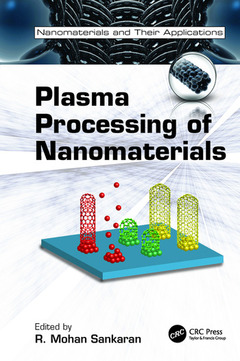Plasma Processing of Nanomaterials Nanomaterials and their Applications Series
Coordonnateur : Sankaran R. Mohan

We are at a critical evolutionary juncture in the research and development of low-temperature plasmas, which have become essential to synthesizing and processing vital nanoscale materials. More and more industries are increasingly dependent on plasma technology to develop integrated small-scale devices, but physical limits to growth, and other challenges, threaten progress.
Plasma Processing of Nanomaterials is an in-depth guide to the art and science of plasma-based chemical processes used to synthesize, process, and modify various classes of nanoscale materials such as nanoparticles, carbon nanotubes, and semiconductor nanowires. Plasma technology enables a wide range of academic and industrial applications in fields including electronics, textiles, automotives, aerospace, and biomedical. A prime example is the semiconductor industry, in which engineers revolutionized microelectronics by using plasmas to deposit and etch thin films and fabricate integrated circuits.
An overview of progress and future potential in plasma processing, this reference illustrates key experimental and theoretical aspects by presenting practical examples of:
- Nanoscale etching/deposition of thin films
- Catalytic growth of carbon nanotubes and semiconductor nanowires
- Silicon nanoparticle synthesis
- Functionalization of carbon nanotubes
- Self-organized nanostructures
Significant advances are expected in nanoelectronics, photovoltaics, and other emerging fields as plasma technology is further optimized to improve the implementation of nanomaterials with well-defined size, shape, and composition. Moving away from the usual focus on wet techniques embraced in chemistry and physics, the author sheds light on pivotal breakthroughs being made by the smaller plasma community. Written for a diverse audience working in fields ranging from nanoelectronics and energy sensors to catalysis and nanomedicine, this resource will help readers improve development and application of nanomaterials in their own work.
About the Author:
R. Mohan Sankaran received the American Vacuum Society?s 2011 Peter Mark Memorial Award for his outstanding contributions to tandem plasma synthesis.
Nanoscale Etching and Deposition. Extreme Ultraviolet Light Lithography for Producing Nanofeatures in Next-Generation Semiconductor Processing. Nonthermal Plasma Synthesis of Semiconductor Nanocrystals. Microscale Plasmas for Metal and Metal Oxide Nanoparticle Synthesis. Large-Scale, Plasma-Assisted Growth of Nanowires. Cathodic Arc Discharge for Synthesis of Carbon Nanoparticles. Atmospheric Plasmas for Carbon Nanotubes (CNTs). Structural Control of Single-Walled Carbon Nanotubes by Plasma Chemical Vapor Deposition. Graphene Growth by Plasma-Enhanced Chemical Vapor Deposition (PECVD). Modeling Aspects of Plasma-Enhanced Chemical Vapor Deposition of Carbon-Based Materials. Modeling Catalytic Growth of One-Dimensional Nanostructures. Diagnostics of Energy Fluxes in Dusty Plasmas. Selective Functionalization and Modification of Carbon Nanomaterials by Plasma Techniques. Plasma–Liquid Interactions for Fabrication of Nanobiomaterials. Assembly and Self-Organization of Nanomaterials.
R. Mohan Sankaran is an Associate Professor of Chemical Engineering at Case Western Reserve University (CWRU) in Cleveland, Ohio. He received his Bachelor’s degree in Chemical Engineering from the University of California at Los Angeles in 1998 and his Ph.D. in Chemical Engineering from the California Institute of Technology in 2004. He joined the Department of Chemical Engineering at CWRU in 2005 as the John C. Angus Legacy Assistant Professor. As a faculty member, he has received several awards, including the CAREER Award from the National Science Foundation, the Young Investigator Program Award from the Air Force Office of Scientific Research, the Camille Dreyfus Teacher-Scholar Award, the Case School of Engineering Research Award, and the Peter Mark Memorial Award from the American Vacuum Society. He is recognized worldwide for his work on atmospheric-pressure microplasmas and their application in nanomaterials synthesis.
Dr. Sankaran received the American Vacuum Society’s 2011 Peter Mark Memorial Award for his outstanding contributions to tandem plasma synthesis.
Date de parution : 04-2017
15.6x23.4 cm
Disponible chez l'éditeur (délai d'approvisionnement : 14 jours).
Prix indicatif 93,24 €
Ajouter au panierDate de parution : 02-2012
Ouvrage de 432 p.
15.6x23.4 cm
Disponible chez l'éditeur (délai d'approvisionnement : 15 jours).
Prix indicatif 232,80 €
Ajouter au panierThèmes de Plasma Processing of Nanomaterials :
Mots-clés :
CNTs; Nanoscale Etching and Deposition; PECVD; Atmospheric Plasmas for Carbon Nanotubes (CNTs); Dusty Plasmas; Diagnotics for Energy Fluxes in Dusty Plasmas; Plasma Surface Interaction; Large-Scale; Plasma-Assisted Growth of Nanowires; MWCNTs; Cathodic Arc Discharge for Synthesis of Carbon Nanoparticles; DBD System; Nathan Marchack; SWNT Growth; Jane P; Chang; Energy Balance; John Sporre; CNT Growth; David N; Ruzic; Si Nanocrystals; Uwe Kortshagen; Plasma Etching; Lorenzo Mangolini; CNWs; Davide Mariotti; Plasma Jet; Uros Cvelbar; American Chemical Society; Mahendra K; Sunkara; Thermal CVD; Manish Chhowalla; Silicon Nanocrystals; H; Emrah Unalan; MC; Jae Beom Park; Particle Temperature; Se Jin Kyung; ZnO NWs; Geun Young Yeom; EUV Light; Rikizo Hatakeyama; Plasma CVD; Toshiaki Kato; EUV Lithography; M; Meyyappan; Nonthermal Plasmas; Jeong-Soo Lee; Plasma Polymerization; Ming Mao; Atmospheric Pressure Plasma; Erik Neyts; Annemie Bogaerts; Eugene Tam; Kostya (Ken) Ostrikov; Tony Murphy; Horst R; Maurer; Holger Kersten; Yuhua Xue; Liming Dai; Toshiro Kaneko; Amanda Evelyn Rider



